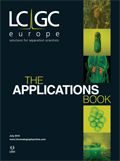Analysis of Artificial Sweeteners by HILIC–MS Method
The Application Notebook
Jonas Henschel1, Alexander Schriewer1, Heiko Hayen1, and Wen Jiang2, 1Institute of Inorganic and Analytical Chemistry, University of Münster, Münster, Germany, 2HILICON AB
In recent decades, the use of artificial sweeteners greatly increased. As sugar substitutes they have become popular in today’s calorieâconscious society. The most commonly used artificial sweeteners in beverages and food are acesulfame, aspartame, cyclamate, neohesperidin dihydrochalcone (NHDC), neotame, saccharin, and sucralose. Some of them show resistance to wastewater treatment and distribute in the aquatic environment as emerging contaminants. In addition, concerns about health risks from the artificial sweeteners have been raised as well (1–3).
The analytical challenge is to simultaneously determine the artificial sweeteners with diverse physicochemical properties. Considering the polar and hydrophilic nature of these compounds, hydrophilic interaction liquid chromatography (HILIC) should be considered as an alternative to commonly used reversed-phase liquid chromatography. In this application, we used one iHILIC-Fusion(+) column packed with charge modulated hydroxyethyl amide silica, which combines hydrophilic partitioning, weak electrostatic interactions, and hydrogen bonding in HILIC separation.

Experimental
LC–MS–MS system: Advance UHPLC with a CTC PAL autosampler and Bruker EVOQ™ Elite triple quadrupole system with electrospray ionization; multiple reaction monitoring mode (MRM) in ESI(+) and ESI(-) was used for selective and sensitive detection, see details in Table 1.
Column: 150 × 2.1 mm, 3.5-µm 100Å iHILIC-Fusion(+) (P/N 100.152.0310, HILICON AB, Sweden)
Gradient elution: A) acetonitrile; B) 10 mM ammonium formate, pH = 3.5; gradient elution from (95/5) A/B to (84/16) A/B in 8.5 min.
Flow rate: 0.3 mL/min
Column temperature: 40 °C
Injection volume: 5 µL
Sample preparation: details on request
Results and Conclusion
Seven artificial sweetener standards can be simultaneously determined by the combination of iHILIC-Fusion(+) HILIC column and EVOQ™ Elite triple quadrupole MS–MS in a 12 min run, as shown in Figure 1. The developed method was verified to detect artificial sweeteners in the diet cola of a well-known brand. After a simple and fast sample preparation, we can identify acesulfame, cyclamate, and aspartame in the tested diet cola (Figure 2).
Figure 1: LC–MS–MS chromatograms of seven artificial sweetener standards with iHILIC-Fusion(+).

Figure 2: LC–MS–MS chromatograms of diluted and degassed diet coke with iHILIC-Fusion(+).

This work describes an efficient HILIC–MS method for separation and detection of artificial sweeteners. It can be further developed to a routine analysis method with a combination of HILIC and aerosol-based detectors (ELSD, NQAD, and CAD) and used in different application areas.
References
- M. Scheurer, H.J. Brauch, and F.T. Lange, Anal. Bioanal. Chem. 394, 1585–1594 (2009).
- F.T. Lange, M. Scheurer, and H.J. Brauch, Anal. Bioanal. Chem.403, 2503–2518 (2012).
- R.A. Lorenzo, M.T. Pena, P. Fernandez, P. Gonzalez, and A.M. Carro, Food Control 47, 43–52 (2015).

HILICON AB
Tvistevägen 48, SE-90736 Umeå, Sweden
Tel.: +46 (90) 193469
E-mail: info@hilicon.com Website: www.hilicon.com

HILIC Peptide Retention Times Predicted Using New Approach
October 29th 2024Manitoba Centre for Proteomics and Systems Biology scientists produced a new means of predicting peptide retention times for hydrophilic interaction liquid chromatography (HILIC) at acidic pH in formic-acid based eluents.
Systematic Evaluation of HILIC Stationary Phases for MS Characterization of Oligonucleotides
Hydrophilic interaction chromatography–mass spectrometry (HILIC-MS) offers a flexible and efficient alternative to ion-pairing reversed-phase liquid chromatography (IP-RPLC) for oligonucleotide analysis, with column selectivity and mobile phase pH being key factors in optimizing retention and detection.